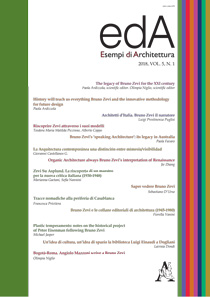Estratto da
ESEMPI DI ARCHITETTURA
International Journal of Architecture and Engineering
History will teach us everything Bruno Zevi and the innovative methodology for future design
ESEMPI DI ARCHITETTURA
International Journal of Architecture and Engineering
History will teach us everything Bruno Zevi and the innovative methodology for future design

Bruno Zevi is one of the most important Italian theorists of architecture. His counter-historical and critical reading of the classical historiography has highlighted a different architectural geography, recognising the merits of that architecture which had been improperly defined minor or peripheral. His reading method aims to minimise the contemplative attitude in favour of involvement and actualization of architectural history far from a historicist approach, that prevents from reading the past as irreplaceable occasion to understand contemporary architecture. In his vision of history as “methodology of architectural doing” he draws not a philological portrait of the past, but a breeding ground for extracting its “forgotten subversive components”. According to Italo Calvino’s statement, a classic art piece is something that never finishes saying what it has to say; Zevi strengthens the concept emphasizing that when architecture of the past was built, the solutions adopted were extremely modern, so they are worth to be analysed to understand processes and ideas they subtended, still valid in contemporaneity. Therefore, it is essential to learn history of architecture by investigating what the masters of the past wanted to achieve rather than the final building just in its components. It is a complex and engaging method because related to “how to look at architecture” with new categories of judgement, that enable to evaluate contemporary architecture by actualization that becomes immediate. It is very useful to unleash oneself, as Zevi suggests, from that compact vision of the historiographical process like the ones handed down by the various Giedion, also by reconsidering the contributions which would make the architecture of countries considered peripheral, substantial. This useful means of reinterpretation can be of educating in universities, considering that it can define new aspects and contradictions in history of so-called official architecture. This paper focuses on strong interaction suggested by Zevi between the architectural design education and history of architecture, as methodology for teaching architectural praxis.
| pagine: | 3-11 |
| DOI: | 10.4399/97888255150531 |
| data pubblicazione: | Maggio 2018 |
| editore: | Aracne |








